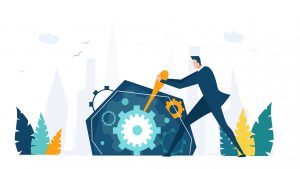- November 3, 2022
- Devin Djerf
- Reading Time: 4 minutes

With the SAP RISE offering approaching its second anniversary, UpperEdge has observed several key insights around SAP’s tactics to drive the adoption of RISE. At this point, the evaluation of RISE is not a question of if; it is a question of when customers will be presented with a RISE proposal to evaluate.
SAP’s strategy has been to market RISE as comprehensive ERP transformational solution inclusive of software, infrastructure, maintenance and technical services. However, as prospective customers explore this offering, they are realizing that not all relevant technical services come standard with RISE, the infrastructure is based on generic t-shirt sizing, and cloud line of business solutions, like Ariba, are out of scope and need to be purchased separately.
Here, we will outline the current state of the market as it relates to RISE, the levers that SAP is pulling to drive cloud adoption, and what customers need to consider when evaluating a move to RISE and negotiating with SAP.
What We’re Seeing
Based on SAP’s aspirations and their expectations conveyed to Wall Street, the changes made to the compensation structure for their salesforce, as well as the strategic alliances formed within their partner ecosystem, it is evident that SAP has gone all-in to aggressively push customers to RISE. As a result, we have seen SAP be forceful in its singular focus to drive customers to select RISE over the perpetual model.
In addition to dedicating new roles to drive RISE adoption, changing the go-to-market ERP transformation strategy, and shifting the incentive structure for its salesforce, there has been notable leadership changes as well. SAP has appointed Dominik Asam as their new CFO, replacing Luka Mucic in the position. Mucic will remain a member of the Executive Board. Additionally, the new head of North America, Lloyd Adams, has stepped in following the departure of DJ Paoni.
We’ll be keeping tabs on how this new leadership team will attempt to influence RISE adoption and if SAP continues to surpass its growth ambitions for RISE. In the meantime, we have outlined the main vendor negotiation tactics to expect from SAP for those clients planning to pursue a RISE evaluation.
RISE vs. Perpetual Tactics
-
Non-Competitiveness of Perpetual Model Discounting
In some cases, SAP has attempted to provide clients with only a RISE proposal and not a perpetual proposal in order to limit their options. When customers are given a perpetual proposal, SAP has implemented terms that drive customers away from the perpetual deal and towards RISE, such as less favorable discounts and reduced commercial term flexibility. Not only are the perpetual discounts generally less than the RISE discounts, but they are also far less than the historical discounts clients used to receive with ECC.
-
Audits
Another tactic SAP has utilized comes in the form of audits. SAP has threatened to launch audits and pursue penalties for non-compliance audit findings unless customers enter into a RISE Agreement. SAP has used other unique circumstances such as Divestitures and Acquisitions to influence RISE adoption as well.
-
Pushing RISE on Net-New Customers
New SAP clients with a greenfield environment should expect an uphill battle obtaining a reasonably competitive perpetual proposal. While there are certainly situations where RISE is more favorable, we recommend new clients pursue both RISE and perpetual proposals in order to conduct a proper evaluation fit.
-
Leveraging the Hyperscalers and SIs
The hyperscalers and Systems Integrators (SIs) are also playing a key role in pushing customers to RISE. For example, at SAP’s Sapphire conference in May, SAP positioned GCP as their premier hyperscaler partner. They also announced a strategic alliance with McKinsey which will focus on business transformation strategy. Additionally, Accenture’s SOAR complements SAP’s RISE offering and is another avenue clients can utilize for adoption. Behind the scenes in certain client programs, it is evident that the hyperscalers and SI’s are in talks with SAP and echo recommendations for RISE.
-
Top-Down Commitment
Additionally, SAP is leveraging executive-level interactions to sell the benefits of RISE, even when the project team believes a perpetual model would be more appropriate. SAP’s talking points include making ‘approval exceptions’ for certain commercial terms and persuading clients that they don’t want to regret being off the growing list of RISE customers.
The Final Decision
As SAP’s aggression towards RISE only continues to grow, it will be important for SAP customers to be aware of SAP’s objectives and sales tactics prior to any upcoming discussions or transactions with SAP. Understanding the tactics that SAP will utilize, including leveraging the influence of their partners, minimizing the flexibility within their perpetual proposals, and driving top-down commitments will help you come to your discussions informed and prepared.
To help mitigate these tactics, we recommend client insist upon receiving a Perpetual proposal from SAP in order to properly evaluate it with the RISE model. We also recommend clients push to receive full transparency across both proposals, assess the risks and operational impacts of both models, and consider the long-term TCO implications.
Customers should assess and evaluate whether RISE is a better alternative to the perpetual model and if they meet your goals. SAP is going to push you towards RISE, but you need to be prepared for the complexities that come with choosing the RISE model. There are a huge number of concepts that need to be unpacked with RISE. You need to understand the different elements of RISE from a pricing, commercial, and capabilities perspective to be able to make this decision and properly negotiate RISE.
Our team of dedicated SAP advisors and SAP RISE experts are available to help guide you through your SAP initiative. With over 100 years of combined experience and 1000 transactions, our SAP team has used their experience to develop their Integrated Sourcing Strategy to help customers navigate the complexities of this journey. Reach out today to learn more about how this integrated approach can work for your company.
This blog was co-authored by Michael Wesseler.
